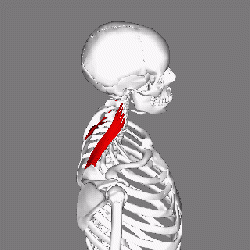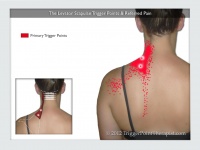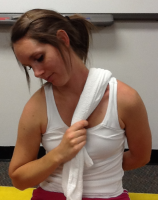Levator Scapulae Syndrome: Difference between revisions
(Added new treatment with references) |
(Level of Evidence updated) |
||
| Line 4: | Line 4: | ||
== Introduction == | == Introduction == | ||
[[Levator_Scapulae_Syndrome|Levator Scapulae Syndrome]] is an historical name for "pain over the upper medial angle of the scapula"<ref name="Menachem">Menachem A1, Kaplan O, Dekel S. Levator scapulae syndrome: an anatomic-clinical study. Bull Hosp Jt Dis. 1993 Spring;53(1):21-4. Level of Evidence 3B</ref> that is still used in clinical practice in some places around the world. This terminology (and use of the word syndrome) describes a set of signs and symptoms that often present together without identifying the cause of the pain and dysfunction, as is the case with other syndromes such as chronic fatigue syndrome and irritable bowel syndrome. It is widely considered better practice to use more specific terminology that refers to relevant causative factors that can be addressed during treatment. | [[Levator_Scapulae_Syndrome|Levator Scapulae Syndrome]] is an historical name for "pain over the upper medial angle of the scapula"<ref name="Menachem">Menachem A1, Kaplan O, Dekel S. Levator scapulae syndrome: an anatomic-clinical study. Bull Hosp Jt Dis. 1993 Spring;53(1):21-4. Level of Evidence 3B</ref> (LoE 3B) that is still used in clinical practice in some places around the world. This terminology (and use of the word syndrome) describes a set of signs and symptoms that often present together without identifying the cause of the pain and dysfunction, as is the case with other syndromes such as chronic fatigue syndrome and irritable bowel syndrome. It is widely considered better practice to use more specific terminology that refers to relevant causative factors that can be addressed during treatment. | ||
== Clinically Relevant Anatomy == | == Clinically Relevant Anatomy == | ||
| Line 14: | Line 14: | ||
== Description == | == Description == | ||
Often this muscle can become tense and painful leading to reduced motion in the area. There is evidence of an association between mechanical neck pain (MNP) and dysfunction of the muscles of the cervical spine<ref>Shaun O'Leary, Deborah Falla, James M. Elliott, Gwendolen Jull. Muscle Dysfunction in Cervical Spine Pain: Implications for Assessment and Management. Journal of Orthopaedic & Sports Physical Therapy, 2009 39(5):324–333 Level of Evidence 5</ref>. The dominant shoulder is most commonly involved (82%) and pain radiates to the neck and shoulder, but rarely to the arm<ref name="Menachem" /> (LoE 3B). | Often this muscle can become tense and painful leading to reduced motion in the area. There is evidence of an association between mechanical neck pain (MNP) and dysfunction of the muscles of the cervical spine<ref>Shaun O'Leary, Deborah Falla, James M. Elliott, Gwendolen Jull. Muscle Dysfunction in Cervical Spine Pain: Implications for Assessment and Management. Journal of Orthopaedic & Sports Physical Therapy, 2009 39(5):324–333 Level of Evidence 5</ref> (LoE 5). The dominant shoulder is most commonly involved (82%) and pain radiates to the neck and shoulder, but rarely to the arm<ref name="Menachem" /> (LoE 3B). | ||
== Causes == | == Causes == | ||
| Line 49: | Line 49: | ||
[[Image:Levator stretch.png|right|200x200px]]It is also important that biomechanical problems that may be contributing to the condition, such as neck or shoulder muscle imbalances, postural problems, or thoracic mobility are identified and corrected as these are usually the causes of increased demands on the levator scapulae. Treatment options include postural advice to ease the demand on the levator scapulae as well as stretching exercises to relieve tension. The levator scapulae can respond well to [[Active Release Techniques|Active Release Techniques]] (ART). | [[Image:Levator stretch.png|right|200x200px]]It is also important that biomechanical problems that may be contributing to the condition, such as neck or shoulder muscle imbalances, postural problems, or thoracic mobility are identified and corrected as these are usually the causes of increased demands on the levator scapulae. Treatment options include postural advice to ease the demand on the levator scapulae as well as stretching exercises to relieve tension. The levator scapulae can respond well to [[Active Release Techniques|Active Release Techniques]] (ART). | ||
Stretching the Levator Scapulae and the surrounding muscles like the trapezius (upper and lower) are beneficial in reducing the pain, increasing range of motion and quality of life. <ref>Cunha, Ana Cláudia Violino et al. “Effect of Global Posture Reeducation and of Static Stretching on Pain, Range of Motion, and Quality of Life in Women with Chronic Neck Pain: A Randomized Clinical Trial.” ''Clinics (Sao Paulo, Brazil)''63.6 (2008): 763–770. ''PMC''. Web. 25 May 2018. Level of Evidence 2A</ref> | Stretching the Levator Scapulae and the surrounding muscles like the trapezius (upper and lower) are beneficial in reducing the pain, increasing range of motion and quality of life. <ref>Cunha, Ana Cláudia Violino et al. “Effect of Global Posture Reeducation and of Static Stretching on Pain, Range of Motion, and Quality of Life in Women with Chronic Neck Pain: A Randomized Clinical Trial.” ''Clinics (Sao Paulo, Brazil)''63.6 (2008): 763–770. ''PMC''. Web. 25 May 2018. Level of Evidence 2A</ref>(LoE 2A) | ||
Muscle strengthening exercises of the Levator Scapulae are also beneficial to correct and prevent any disbalance in the neck <ref>Bae, Won-Sik et al. “The Effect of Middle and Lower Trapezius Strength Exercises and Levator Scapulae and Upper Trapezius Stretching Exercises in Upper Crossed Syndrome.” ''Journal of Physical Therapy Science'' 28.5 (2016): 1636–1639. ''PMC''. Web. 25 May 2018. Level of Evidence 2B</ref> (Upper crossed syndrome) which is correlated to bad posture and tension in the muscles. | Muscle strengthening exercises of the Levator Scapulae are also beneficial to correct and prevent any disbalance in the neck <ref>Bae, Won-Sik et al. “The Effect of Middle and Lower Trapezius Strength Exercises and Levator Scapulae and Upper Trapezius Stretching Exercises in Upper Crossed Syndrome.” ''Journal of Physical Therapy Science'' 28.5 (2016): 1636–1639. ''PMC''. Web. 25 May 2018. Level of Evidence 2B</ref> (LoE 2B) (Upper crossed syndrome) which is correlated to bad posture and tension in the muscles. | ||
== References == | == References == | ||
Revision as of 17:17, 25 May 2018
Top Contributors - Andeela Hafeez, Rachael Lowe, Tony Lowe, Kim Jackson, Alexander De Bock, WikiSysop, Eugenie Lamprecht, Robin Meynendonckx, Shwe Shwe U Marma, 127.0.0.1, Kishan Muthukuda and Evan Thomas
Introduction[edit | edit source]
Levator Scapulae Syndrome is an historical name for "pain over the upper medial angle of the scapula"[1] (LoE 3B) that is still used in clinical practice in some places around the world. This terminology (and use of the word syndrome) describes a set of signs and symptoms that often present together without identifying the cause of the pain and dysfunction, as is the case with other syndromes such as chronic fatigue syndrome and irritable bowel syndrome. It is widely considered better practice to use more specific terminology that refers to relevant causative factors that can be addressed during treatment.
Clinically Relevant Anatomy[edit | edit source]
The levator scapulae muscle extends from C1-4 to the medial aspect of the scapula, between the superior angle and the root of the spine. Its function is to assist with various neck, arm and shoulder movements such as shoulder elevation and cervical side flexion.
Description[edit | edit source]
Often this muscle can become tense and painful leading to reduced motion in the area. There is evidence of an association between mechanical neck pain (MNP) and dysfunction of the muscles of the cervical spine[2] (LoE 5). The dominant shoulder is most commonly involved (82%) and pain radiates to the neck and shoulder, but rarely to the arm[1] (LoE 3B).
Causes[edit | edit source]
- Cervical spine dysfunction.
- Altered shoulder biomechanics or poor posture.
- Repetitive arm motions such as in swimming, throwing, or racquet sports.
- Carrying bags with straps over the shoulder.
- Stress / anxiety, many people who experience the effects of these trigger points also complain of a shortness of breath (similar to that associated with panic attacks).
Sign and Symptoms[edit | edit source]
- Neck pain, which may extend to the head causing a headache.
- Pain and restricted range of movement, especially reduced cervical flexion and side flexion to the contralateral side.
- Deep, achy pain and/or tightness on the upper back along the top of the shoulder blade or neck.
- Increased muscle tone and trigger points. Active trigger points are more frequent in patients presenting with mechanical neck pain[3](LoE 1B)
Trigger points[edit | edit source]
The Levator Scapulae can present with two trigger points located in the lower half of the muscle. The lower trigger point lies just above the superior angle of the scapula and upper trigger point lies 1-3 inches above the lower trigger point. Both trigger points lie deep to the upper trapezius muscle. Both trigger points refer pain laterally to the shoulder and along the medial aspect of the shoulder blade.
Examination[edit | edit source]
With this presentation of pain and trigger points in the region of the levator scapulae it is important to complete a full assessment of the cervical spine as pain in this region is often referred from the cervical spine. The presenting pain is likely to be reproduced on active and passive range of movement testing of the cervical spine especially flexion and side flexion to the contralateral side. The muscle is also likely to be tender on palpation and may present with increased tone, especially in the region of the trigger points.
You must also rule out the thoracic spine and shoulder. The phenomenon of levator scapulae pain of cervical origin being reproduced on shoulder movement has long been clinically recognised[4](LoE 3A).
Treatment[edit | edit source]
Primary treatment with be aimed at the dysfunction that you hypothesise to be causing the levator scapulae dysfunction i.e. the cervical spine.
It is also important that biomechanical problems that may be contributing to the condition, such as neck or shoulder muscle imbalances, postural problems, or thoracic mobility are identified and corrected as these are usually the causes of increased demands on the levator scapulae. Treatment options include postural advice to ease the demand on the levator scapulae as well as stretching exercises to relieve tension. The levator scapulae can respond well to Active Release Techniques (ART).
Stretching the Levator Scapulae and the surrounding muscles like the trapezius (upper and lower) are beneficial in reducing the pain, increasing range of motion and quality of life. [5](LoE 2A)
Muscle strengthening exercises of the Levator Scapulae are also beneficial to correct and prevent any disbalance in the neck [6] (LoE 2B) (Upper crossed syndrome) which is correlated to bad posture and tension in the muscles.
References[edit | edit source]
- ↑ 1.0 1.1 Menachem A1, Kaplan O, Dekel S. Levator scapulae syndrome: an anatomic-clinical study. Bull Hosp Jt Dis. 1993 Spring;53(1):21-4. Level of Evidence 3B
- ↑ Shaun O'Leary, Deborah Falla, James M. Elliott, Gwendolen Jull. Muscle Dysfunction in Cervical Spine Pain: Implications for Assessment and Management. Journal of Orthopaedic & Sports Physical Therapy, 2009 39(5):324–333 Level of Evidence 5
- ↑ C. Fernández-de-las-Peñas, C. Alonso-Blanco, J.C. Miangolarra. Myofascial trigger points in subjects presenting with mechanical neck pain: A blinded, controlled study. Manual Therapy, 2007, 12(1):29–33 Level of Evidence 1B
- ↑ Behrsin JF and Maguire K. Levator Scapulae Action during Shoulder Movement: A Possible Mechanism for Shoulder Pain of Cervical Origin. Australian Journal of Physiotherapy, 1986, 32(2):101–106 Level of Evidence 3A
- ↑ Cunha, Ana Cláudia Violino et al. “Effect of Global Posture Reeducation and of Static Stretching on Pain, Range of Motion, and Quality of Life in Women with Chronic Neck Pain: A Randomized Clinical Trial.” Clinics (Sao Paulo, Brazil)63.6 (2008): 763–770. PMC. Web. 25 May 2018. Level of Evidence 2A
- ↑ Bae, Won-Sik et al. “The Effect of Middle and Lower Trapezius Strength Exercises and Levator Scapulae and Upper Trapezius Stretching Exercises in Upper Crossed Syndrome.” Journal of Physical Therapy Science 28.5 (2016): 1636–1639. PMC. Web. 25 May 2018. Level of Evidence 2B









